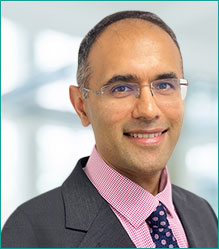
Big Toe Arthritis Specialist in High Wycombe, Buckinghamshire and Elstree
Big toe arthritis is a form of degenerative arthritis affecting the joint where the big toe (hallux) attaches to the foot. The toe typically becomes stiff at the base and is sometimes called a “frozen joint”. The condition often results in swelling, pain around the big toe and discomfort while walking due to restricted movements of the big toe. Precision Foot and Ankle, Orthopaedic Surgeon, Mr. Kinner Davda provides expert diagnosis and individualised non-operative and operative treatments for big toe arthritis in High Wycombe, Buckinghamshire and Elstree. Contact Precision Foot and Ankle, Orthopaedic Surgeon, Mr Kinner Davda or his team at any of these locations for an appointment today!
- Request an Appointment
- Secretary
- HCA Esltree
- BMI Shelburne
- BMI Chiltern
What is Big Toe Arthritis?
Arthritis refers to ‘wear and tear’ of a joint. This may occur at the base of the big toe. A common medical term for this condition is ‘hallux rigidus’, Latin for ‘stiff big toe’. The exact cause is unknown but is associated with those who are active, or have suffered gout, or other inflammatory conditions such as rheumatoid disease.
What are the symptoms?
You may feel a hard lump or ridge around the base of the big toe. This is overgrown bone from the wear and tear process. It is a natural response by the body. The toe may be stiff, particularly when trying to bring it in an upward direction. Pain may be felt when standing and made worse when walking or running. This may cause you to walk on the outer border of the foot. The symptoms may also be felt at night as a dull aching sensation. As the joint wears away more, it may tilt and begin to encroach on the second toe.
Diagnosis
Mr Davda will take a thorough history and clinical evaluation. Conditions such as diabetes and the vascularity of the foot will be examined. A weight-bearing x-ray of the foot will be taken to examine the severity of the arthritis. This will determine the type of treatment that will be most appropriate for you.
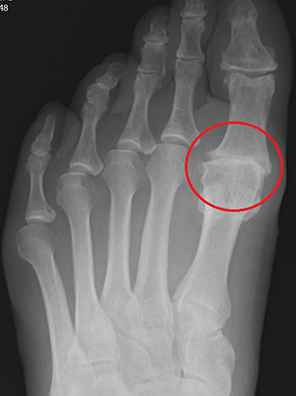
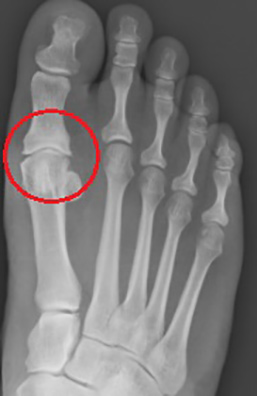
The x-rays above show the big toe joint. The x-ray on the right shows moderate changes to the joint. Although the joint surfaces have some arthritic change, there is still some space between the bones. The x-ray on the right shows more severe arthritis, where there is bone rubbing on bone.
Treatment
Big toe arthritis in the early stages can be treated initially without an operation using the measures below:
- Insoles/Firm soled shoes
These limit the amount of movement in the big toe joint, which may improve your symptoms. Tender areas on top of the big toe that are uncomfortable may be relieved by the use of protective pads made of silicone and or lamb’s wool. These provide cushioning to prominent or tender areas.
- Painkillers
Anti-inflammatory medication such as ibuprofen may help if taken regularly. Local gels and creams may also be of benefit.
- Manipulation and steroid injection
This procedure does not involve any open cuts. It can be carried out under local anaesthetic in the radiology department, or under general anaesthetic as a day case procedure. A gentle manipulation is performed, whereby the big toe joint is stretched in an upward and downward range of movement. This releases the contracture and stiffness in the joint. The steroid component of the injection helps to reduce pain and inflammation in the joint. This will take 6-8 weeks to have an effect. Importantly, the steroid used is a low dose, only in the joint, and does not affect the rest of the body. The injection also contains local anaesthetic which will provide pain relief for the first few days after. General aspect of foot and ankle injections are covered here. Importantly, the injection does not cure the underlying arthritis and further treatment may be needed.
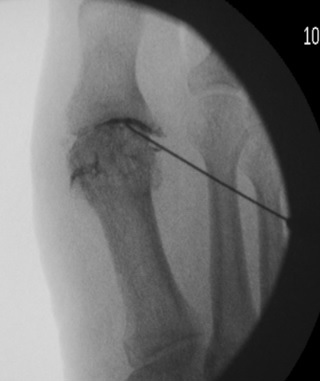
The x-ray above shows an injection to the big toe joint. A dye is used to locate the joint, and then local anaesthetic and steroid are then passed into the joint.
Surgery
Surgery should only be considered if all non-surgical measures above have been tried, or if the arthritis is advanced and if symptoms are significant. The most common procedures are outlined below.
Cheilectomy
This procedure involves removing the bone bump, felt at the base of the big toe joint, just under the skin. This is done if the arthritis is moderate and affects the top half of the joint. A small incision will be made along the side of the big toe and the bump gently removed. This allows the range of movement to increase, particularly in pulling the toes upward. It does not cure the arthritic process. There is about an 80% chance of this surgery being successful for up to 5 years. If a cheilectomy fails to improve your symptoms, then a fusion may be undertaken at a later date.
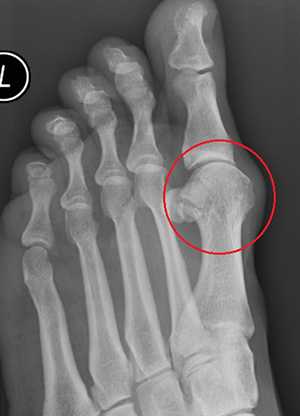
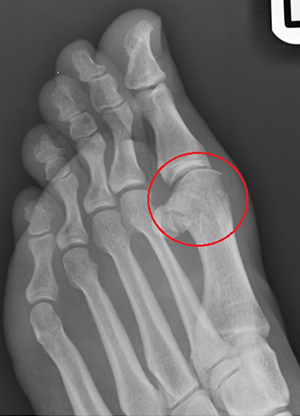
The figure on the left shows a bone ridge along the top of the big toe joint. This is felt as a bump under the skin. The figure on the right shows the post-operative appearance once the bump has been removed as part of the cheilectomy procedure.
Fusion
This operation is the gold standard in big toe arthritis and is 90% successful. It aims to relieve your pain, improve function, and align the big toe. A stiff painful joint is essentially converted to a stiff painless joint. Hence you are unlikely to notice any great change in the movement of the toe, but rather that it no longer aches.
An incision is made along the side of the big toe and the arthritic joint removed. The bones are then fixed together using plates or screws. These compress the joint so that the bone ends can begin to heal and knit together. You will still be able to bend the toe at the tip and movement from the midfoot will remain.
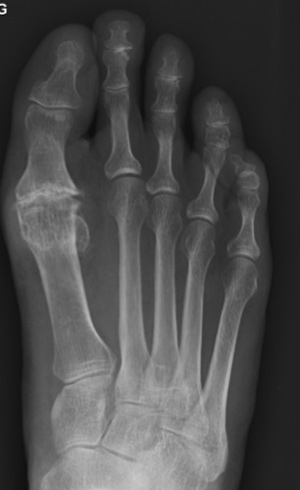
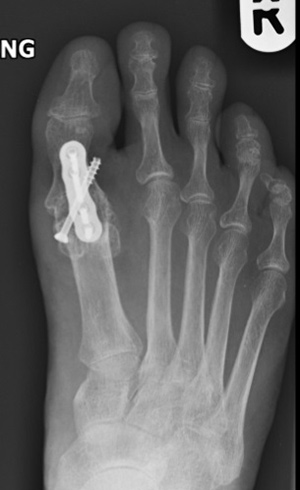
The x-ray on the left shows severe big toe arthritis. This has been fused with a plate and screws as shown on the right.
Joint Replacement
Fusion surgery remains the gold standard for the majority of patients. Many different joint replacements have come on to the market over the years, however associated complications have prevented their widespread adoption as the procedure of choice. In some instances, where arthritis not only affects the big toe joint but also the joints above and below, a plastic replacement can be considered. This may be the case in patients with conditions such as rheumatoid arthritis. The arthritic joint is removed in a similar fashion as fusion surgery, and a plastic hinge inserted. This returns some movement back to the joint, but not full movement.
On the day of surgery
You will be seen by Mr Davda or a member of the team to check your consent and mark the leg. Big toe surgery is typically performed under general anaesthetic, which can be discussed with your anaesthetist.
Surgery will take about an hour, more if further work is required to address lesser toe deformities. The whole process of taking you to the operating theatre, having surgery and recovering from anaesthetic thereafter will take about half a day.
In most cases, you will be able to go home the same day. Sometimes, it is necessary to spend a night in hospital depending on your general health and immediate recovery from the operation. Local anaesthetic is also applied at the time of surgery to provide pain relief and numb the foot. This can last for up to a day after.
The foot and ankle will be dressed wrapped in a bandage which stays on until the first post-operative check about two weeks following surgery. This should be kept dry if possible. The bandage can be placed in a plastic bag or commercially available liners when showering.
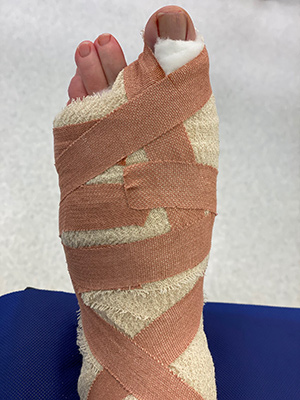
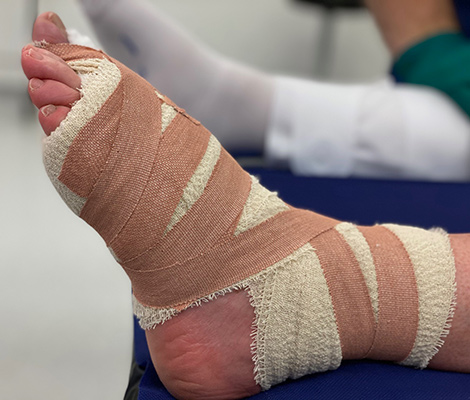
The big toe will be wrapped in a bandage following surgery as shown above. This will be changed about two weeks following surgery for a fresh bandage.
After The Operation
It is not uncommon for the wound to bleed a little and stain the bandaging, particularly when standing for the first time after the operation. You will be provided a special shoe which helps to off load weight from the forefoot. The physiotherapist will give you instructions on how to wear the shoe and in the use of elbow crutches if required.
For the first two weeks following surgery, you are advised to elevate the foot on 2-3 pillows as much as possible and limit the amount you walk to as little as practically possible. This will help reduce the swelling in the foot and promote healing of the wound.
At about two weeks, you will be seen in the post-operative clinic, or by the local practice nurse if closer, when the wound will be checked, and the bandage reapplied. At your next appointment about 6 weeks following surgery, dressings will be removed completely and a check x-ray taken. Further follow up at 3 and 6 months will be organised.
Recovery for specific procedures
Cheilectomy
The recovery period is usually quicker following this operation than for fusion. A stiff-soled shoe is provided for you to wear for the first 2 weeks, after which you may wear a normal shoe. Once the wound has been checked and the bandages removed, you are encouraged to exercise the joint by holding your big toe and gently moving it up and down. Performing these exercises early and regularly allows for the best possible result from your surgery.
You may not start feeling the benefit of the procedure until about 6 weeks afterwards, and your symptoms should then continue to improve for up to 12 months.
Fusion
The recovery period for a fusion is a lengthier process than that of a cheilectomy. It will take about 6 weeks for your pain level to reduce. The pain, and swelling will continue to improve for up to 12 months. It will be a further 6 to 8 weeks before you are able to wear a standard shoe.
Common Questions
When can I drive?
Patients having had their left foot operated on will be able to drive an automatic car within two weeks. Those who have had an operation on the right side will be able to drive after about 6 weeks. You must be able to perform an emergency stop. You are advised to contact your insurance company to ensure you are covered to drive.
When can I fly?
You are advised not to fly after surgery for 6 weeks until a check x-ray has been done. The metalwork is very unlikely to set off alarms at airport security.
When can I go back to work?
This will depend on the type of work you do. For example, if you have a desk job you may be able to return to work after two weeks provided you are able to rest and elevate your foot whilst sitting. If you do a physically demanding job, you may need 8-10 weeks off.
When can I return to sport?
You can usually return to sports between three and six months from the date of surgery. Recreational walking or light sporting activity may be resumed earlier once an x-ray has been performed to check the big toe has completely fused. It is unlikely you will be able to return to high impact sport such as football or racquet games.
Can I wear high heels?
You may be able to wear a shoe with a small heel wedge of a few centimetres may be possible, but not high heels. The foot will be puffy and swollen for the first 6-9 months following surgery.
Complications of Surgery
Forefoot surgery has a success rate of over 90% but, as with all operations, complications can occur. You should not contemplate surgery for cosmetic reasons only.
Specific to cheilectomy
Stiffness - this can occur in the big toe joint. We encourage you to gently move the big toe up and down after surgery at periodic intervals. If the stiffness continues and movement from the big toe is lost, a manipulation and steroid injection may be required. This is an uncommon occurrence.
Failure to relieve pain - patients may continue to have pain following cheilectomy and may then require a fusion.
Specific to fusion
Position – the big toe may heal in a position that is uncommon and may necessitate further surgery.
Shortening – as the arthritic joint needs to be removed, the big toe will need to be shortened in order for the bone ends to meet and knit together. Hence the big toe may appear short compared to the opposing big toe.
Non union of bone. This is where the bones fail to join together. This may occur if you are diabetic, smoke or have a condition such as rheumatoid arthritis. This can also occur if excessive weight-bearing has occurred in the initial stages following surgery.
Smoking – If you smoke, your risk of nonunion or major complications are greatly increased. It is therefore essential that you stop smoking before surgery and refrain from smoking until all bones have healed.
Metalwork – screws or plates may be felt once the post-operative swelling settles. The metalwork can be removed, if it causes irritation or pain, at about a year following the first surgery.
General complications
Swelling – this is very common after surgery. It is a side effect, rather than a complication, and can take up to a year to recover. You may need a shoe size slightly larger than you normally wear during this period.
Infection – this can occur in a small percentage of patients. If this is the case, it is possible that further surgery may be required to remove infected bone or screws. Minor infections are commoner and normally settle after a short course of antibiotics.
Numbness and tingling – this occurs at the surgical site, as a result of minor nerve damage and usually recovers over the course of six months.
Blood clots – A clot in the calf of the operated foot (known as deep vein thrombosis or DVT), or a clot in the lung (known as pulmonary embolus or PE) is rare. Please inform the team if you have had a DVT or PE before, or if you have a family history of clotting disorders. You may require a short course of a blood-thinning injection if this is the case, or if operating on both feet at the same time.
